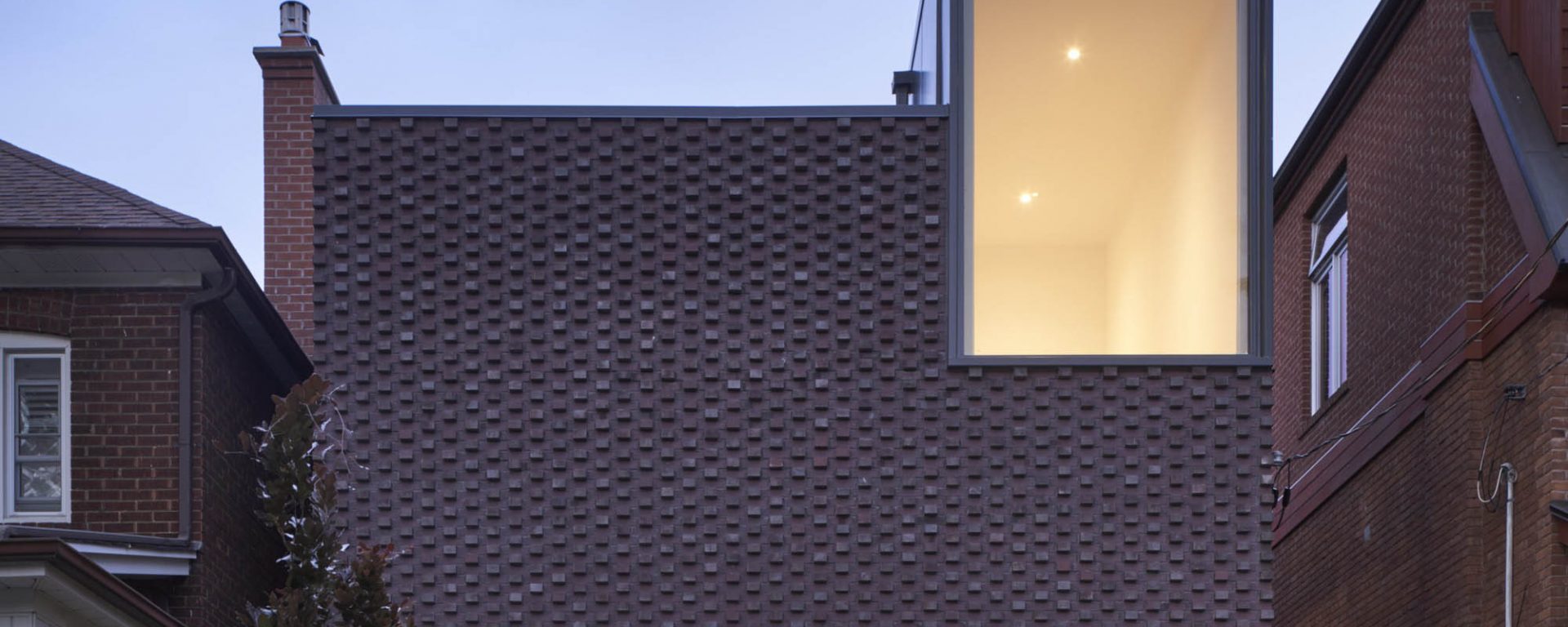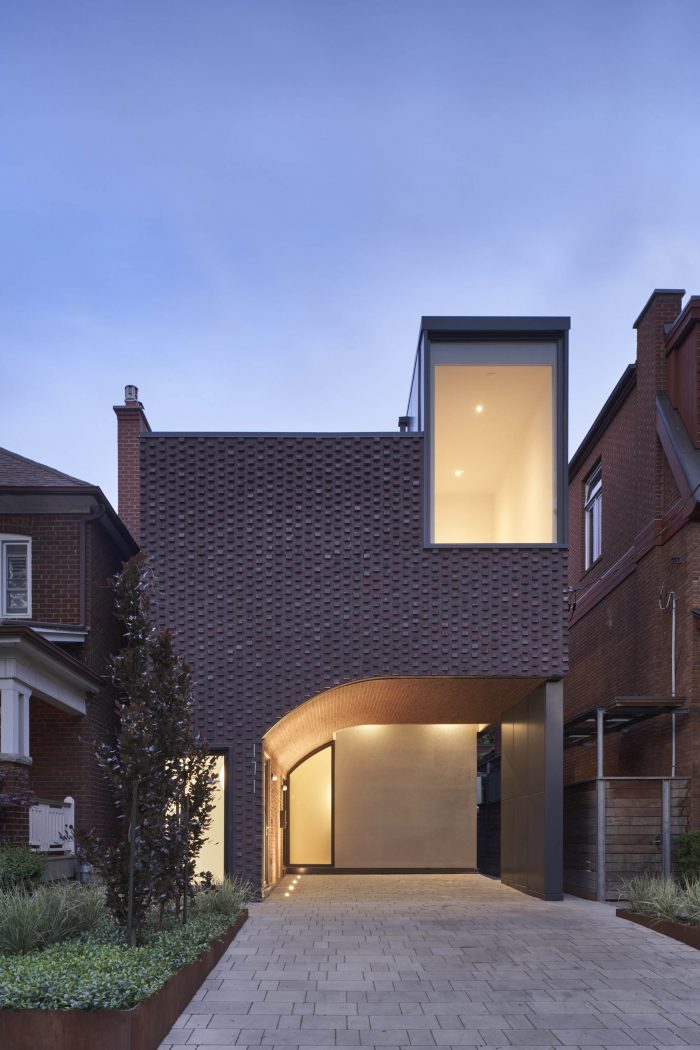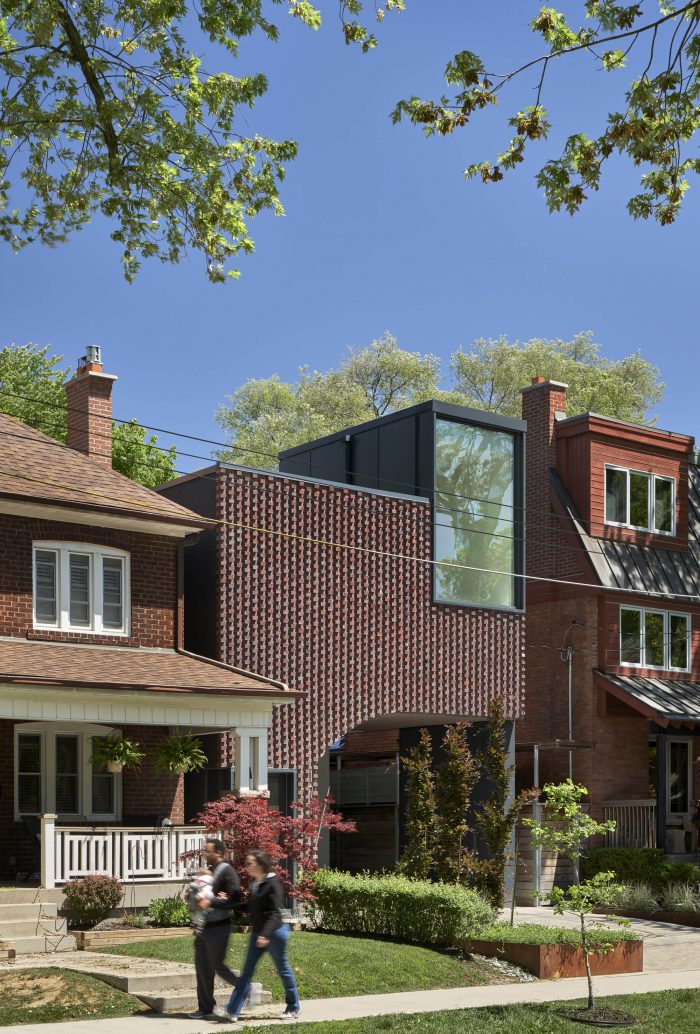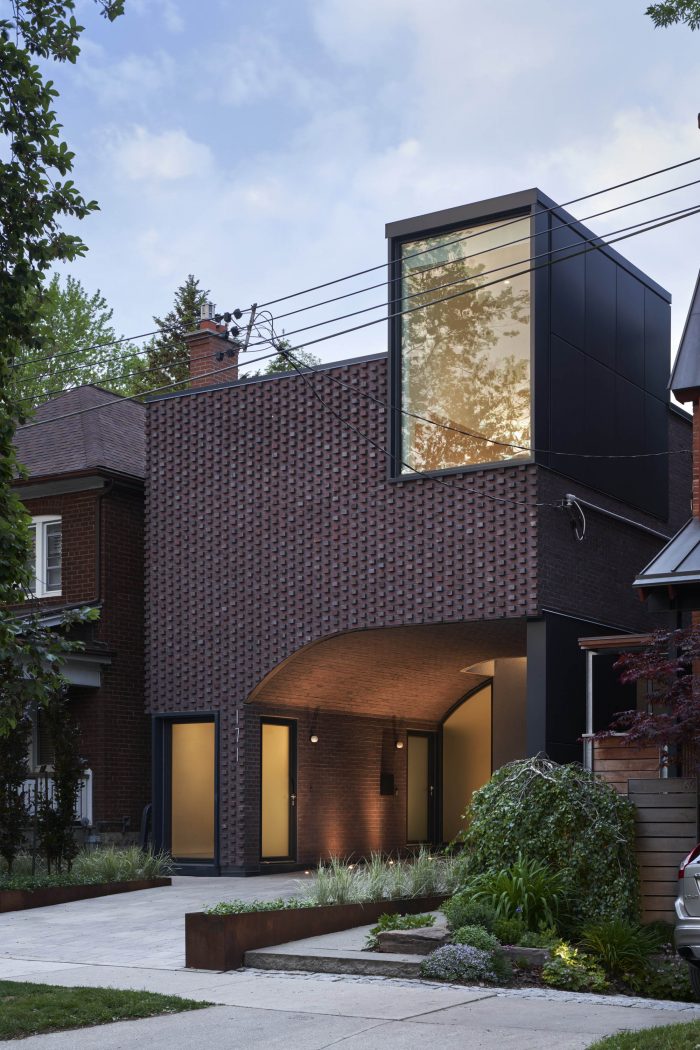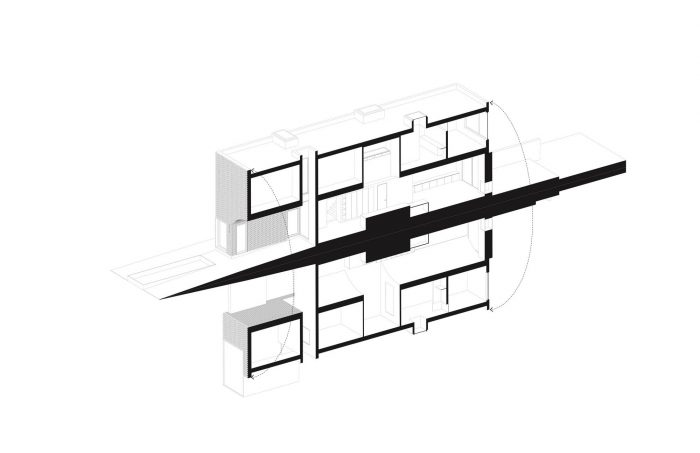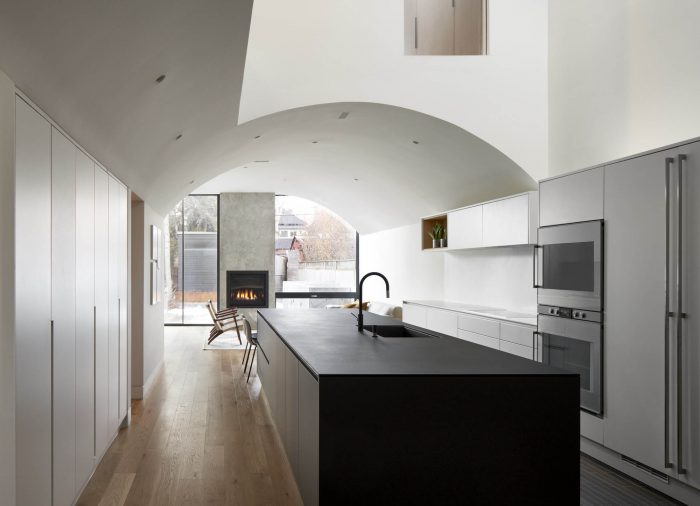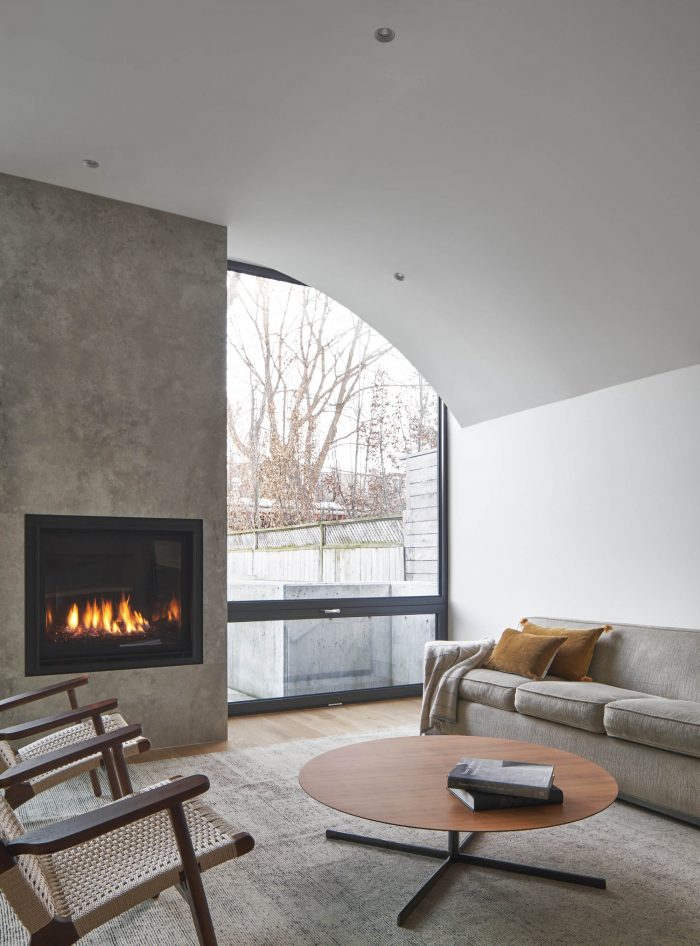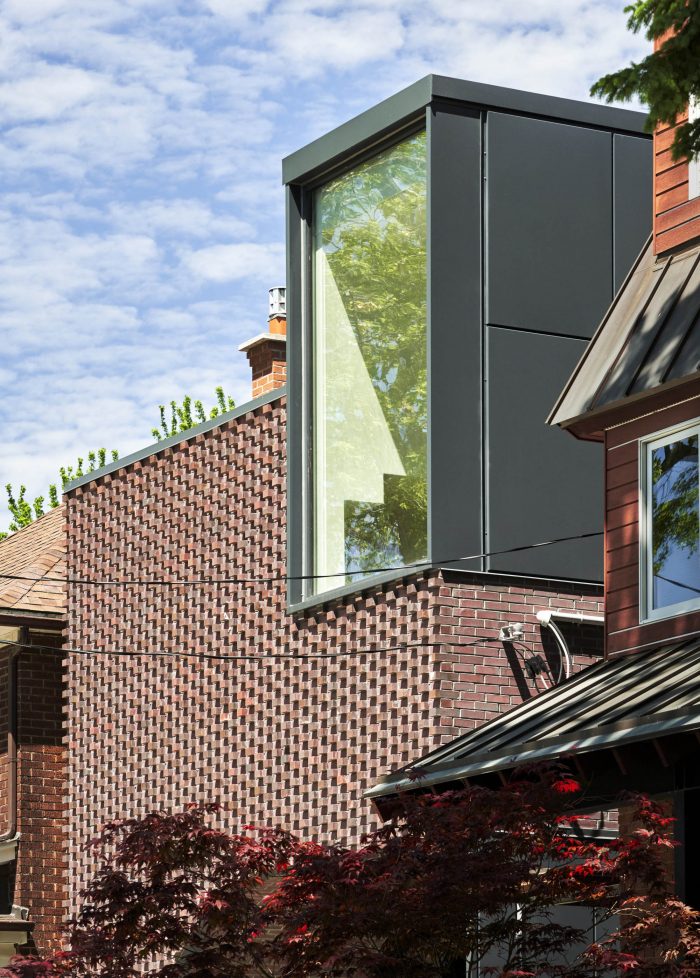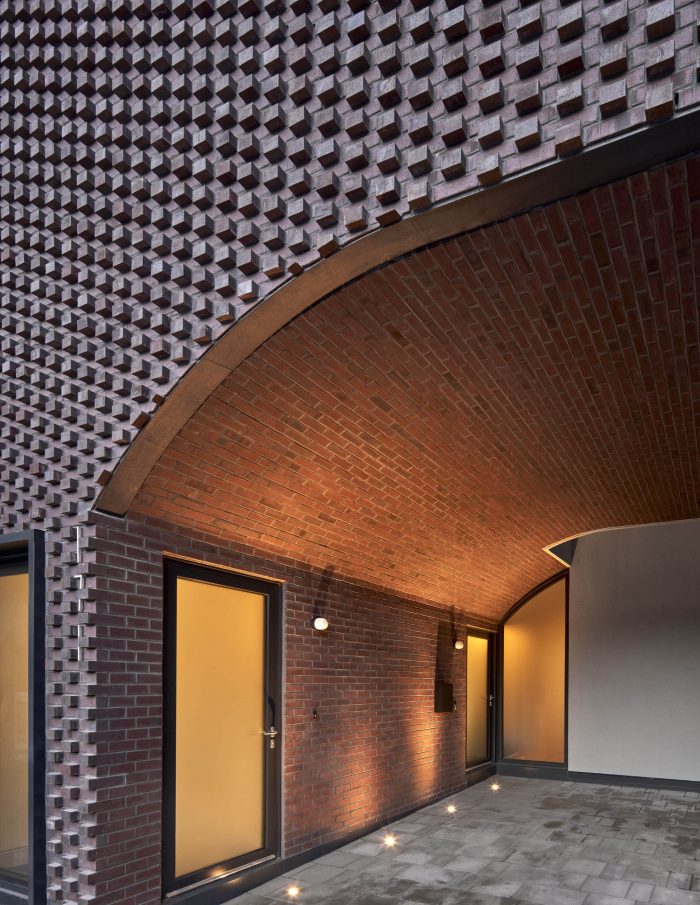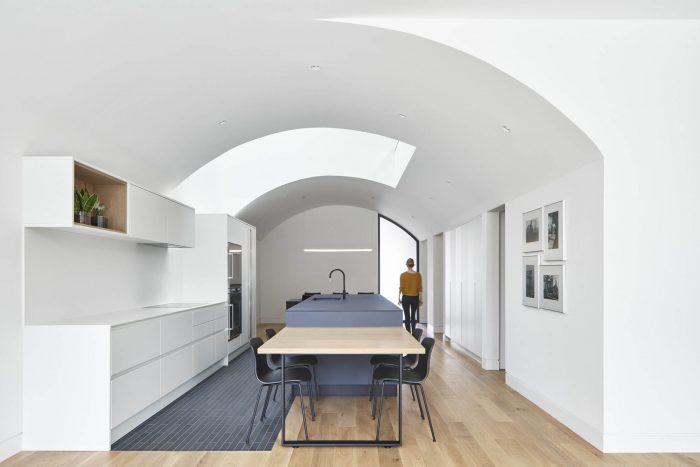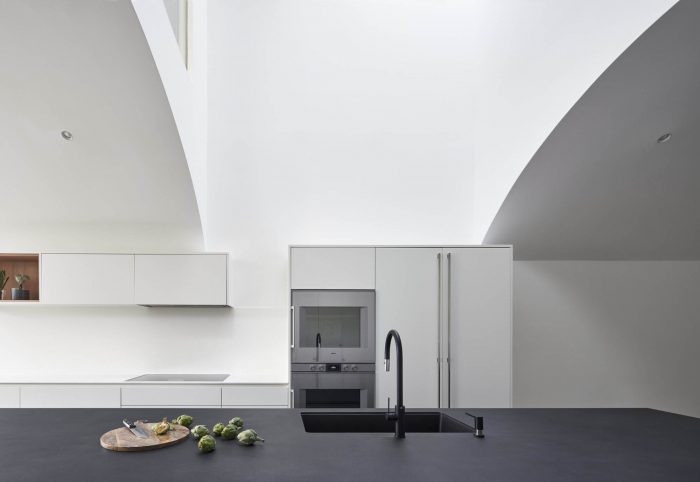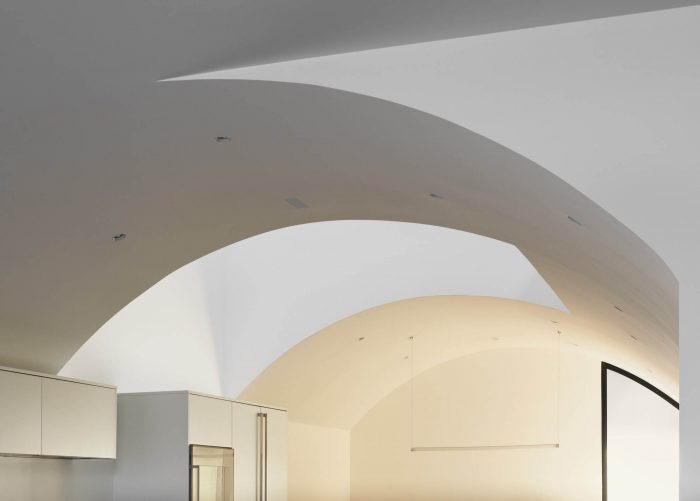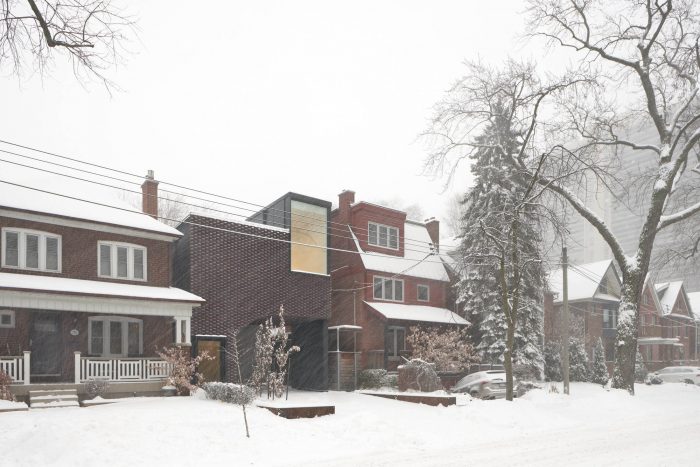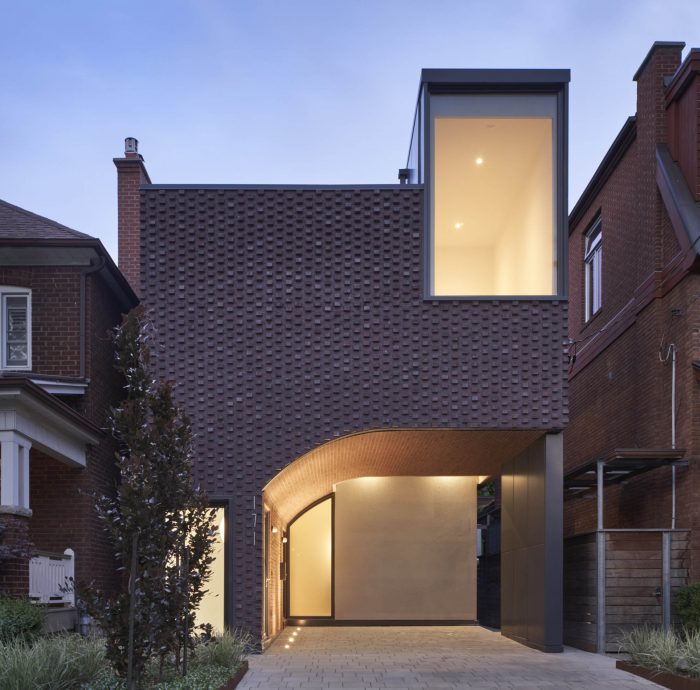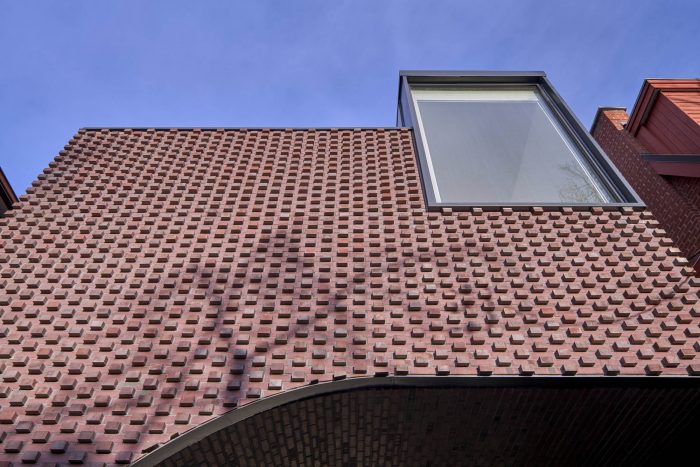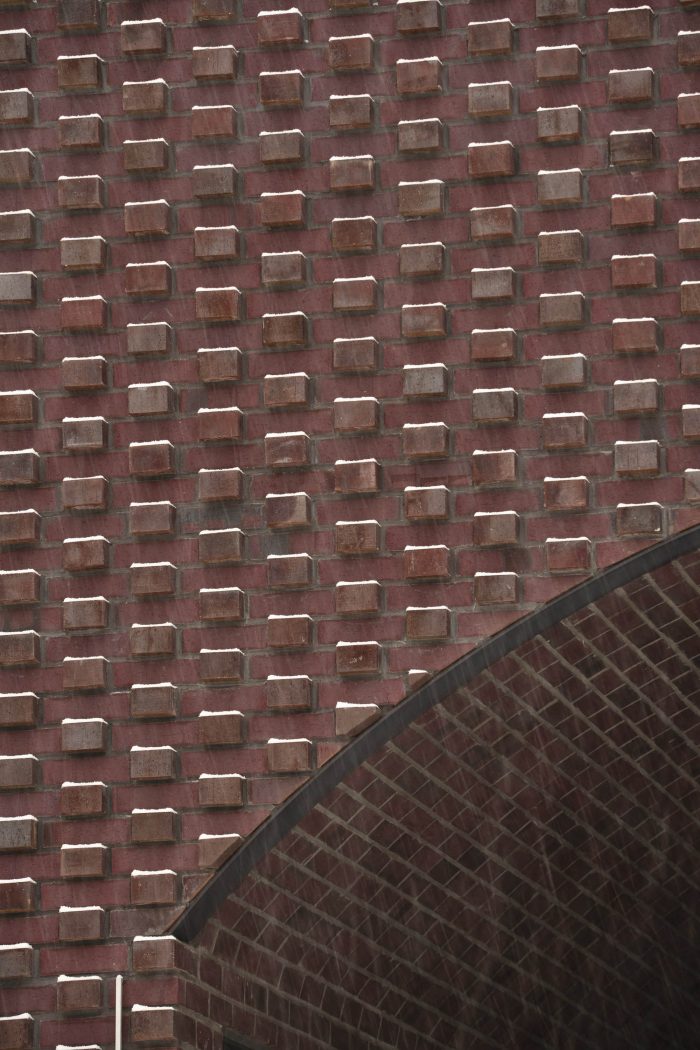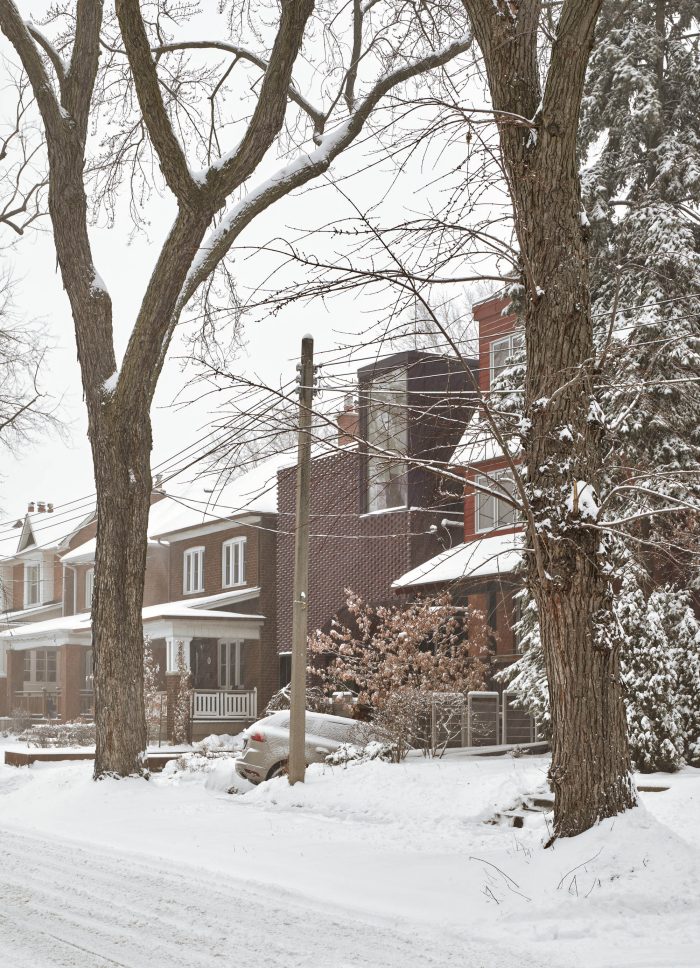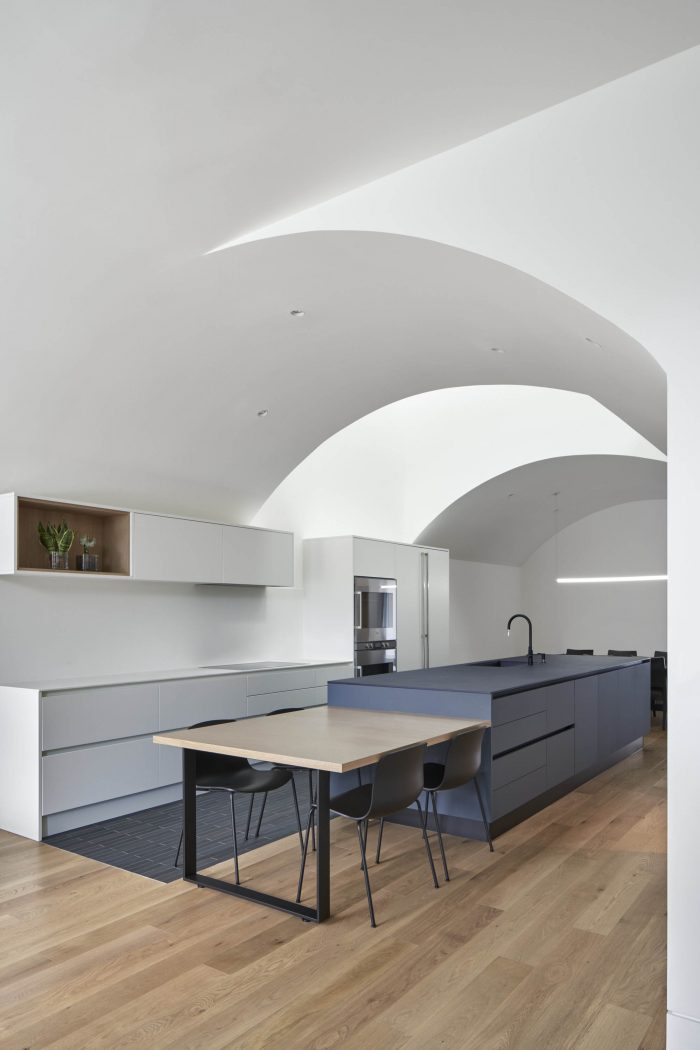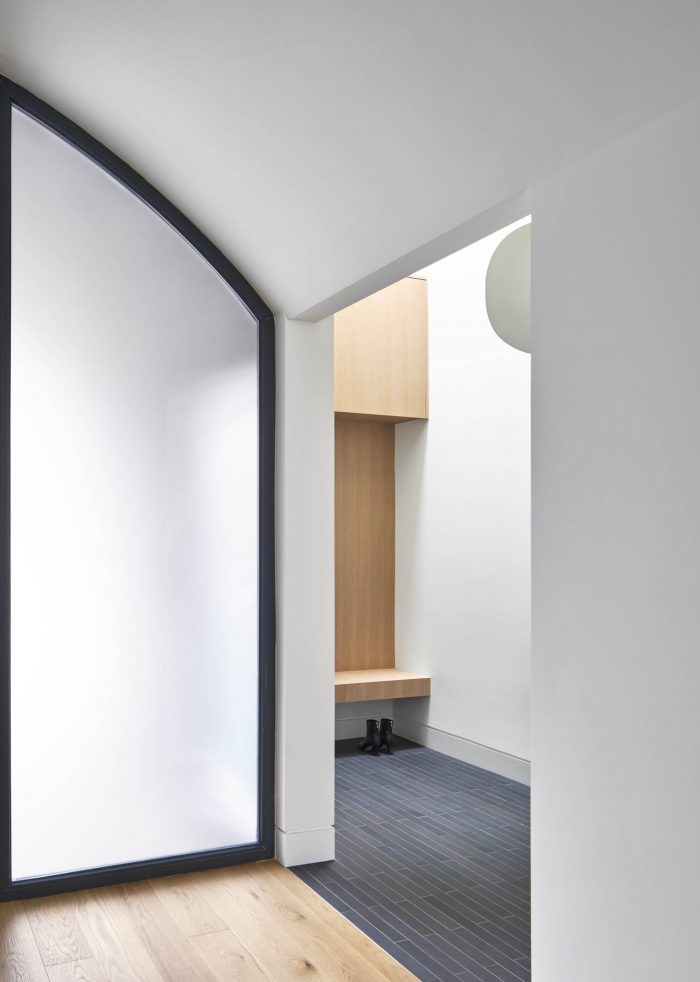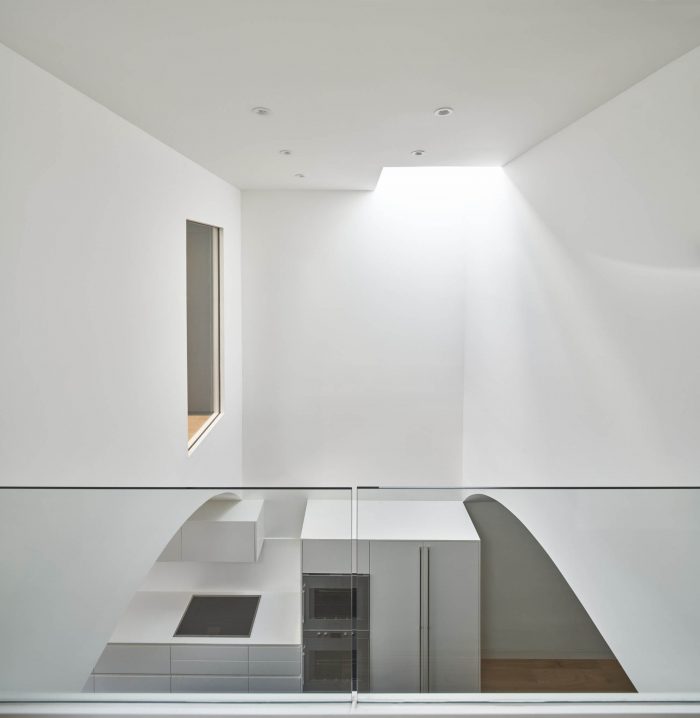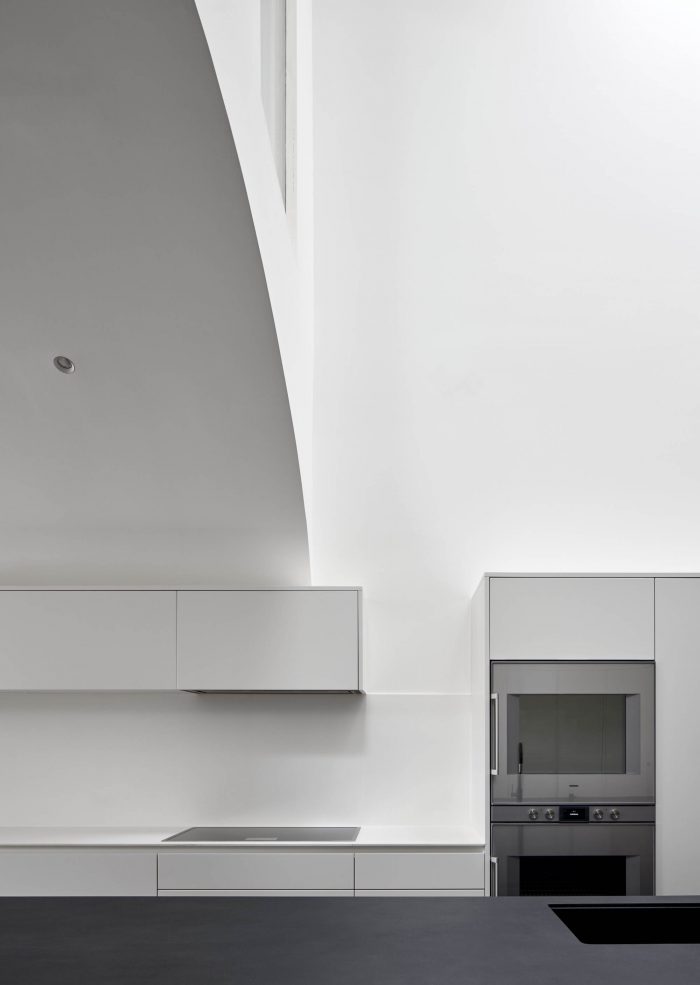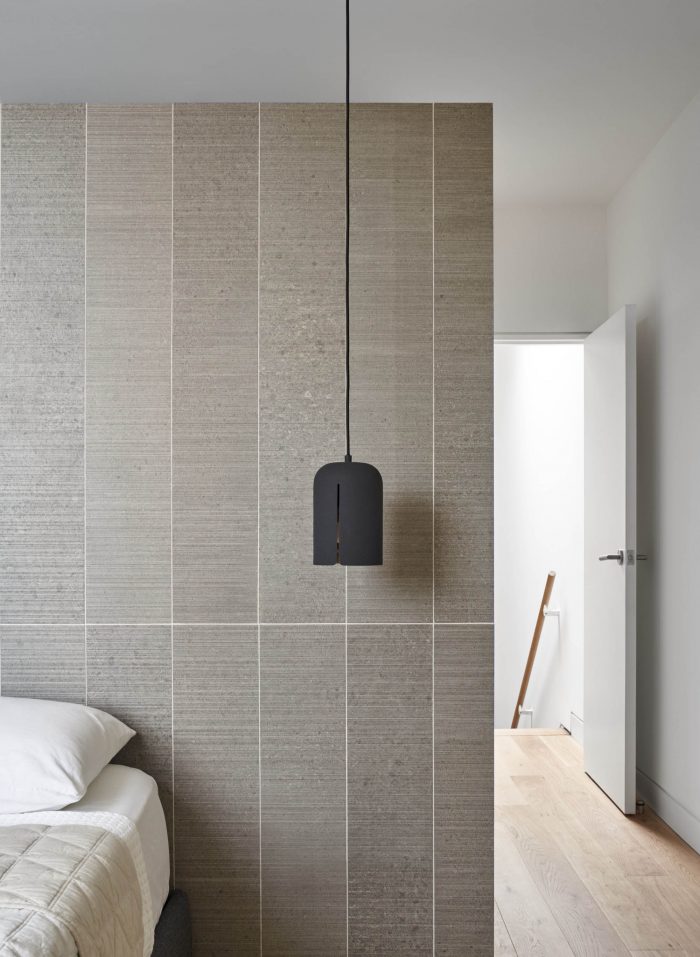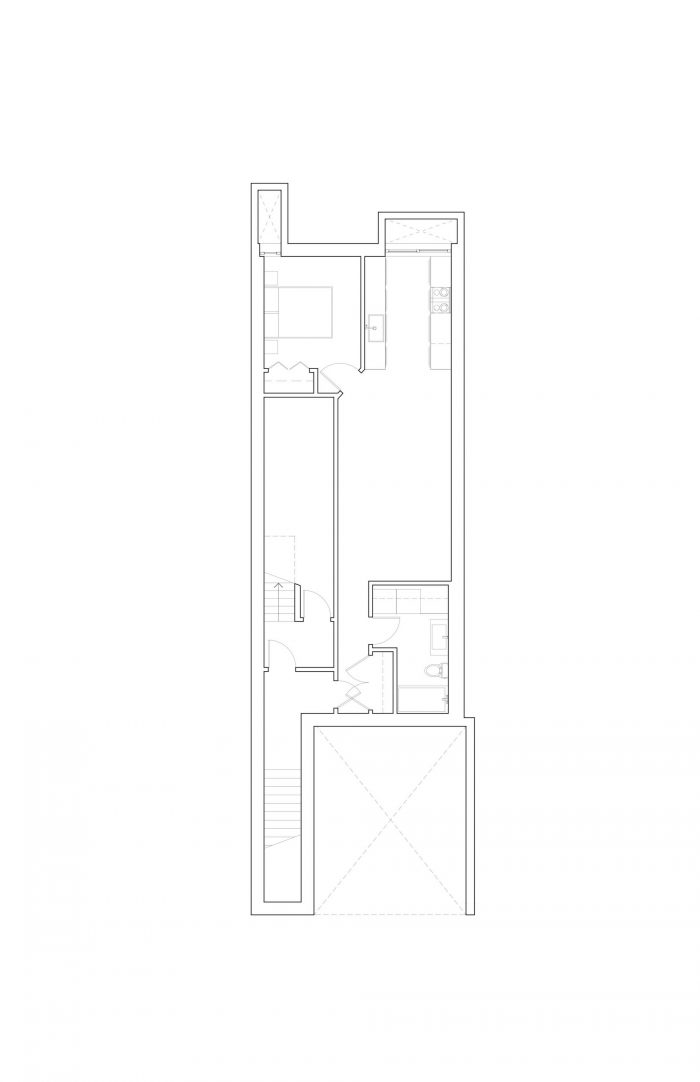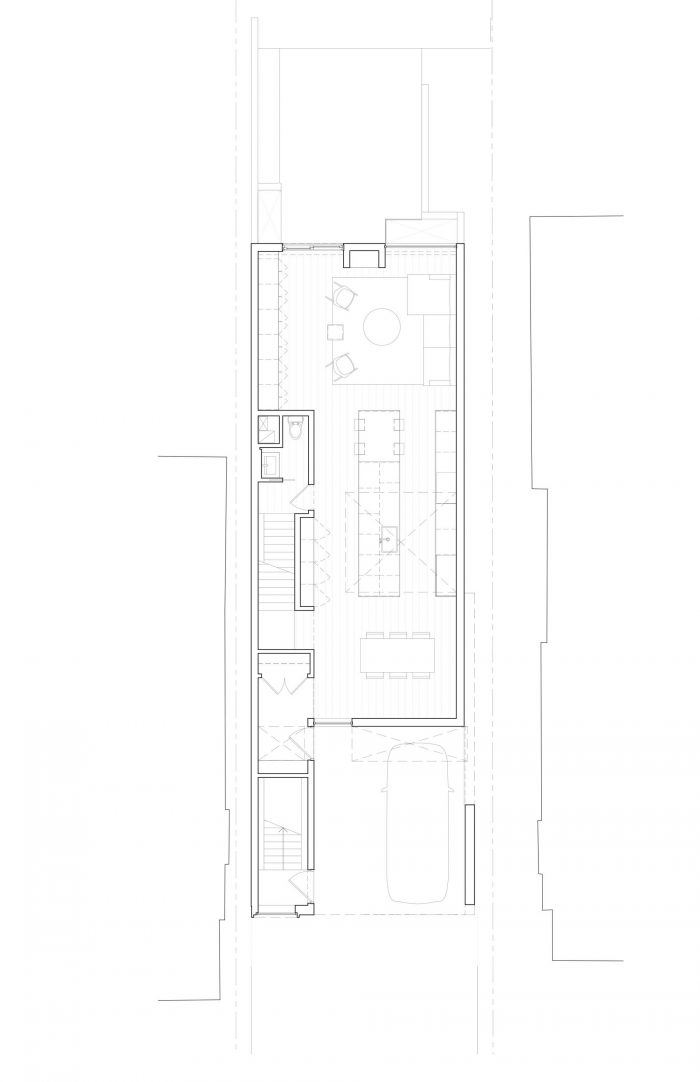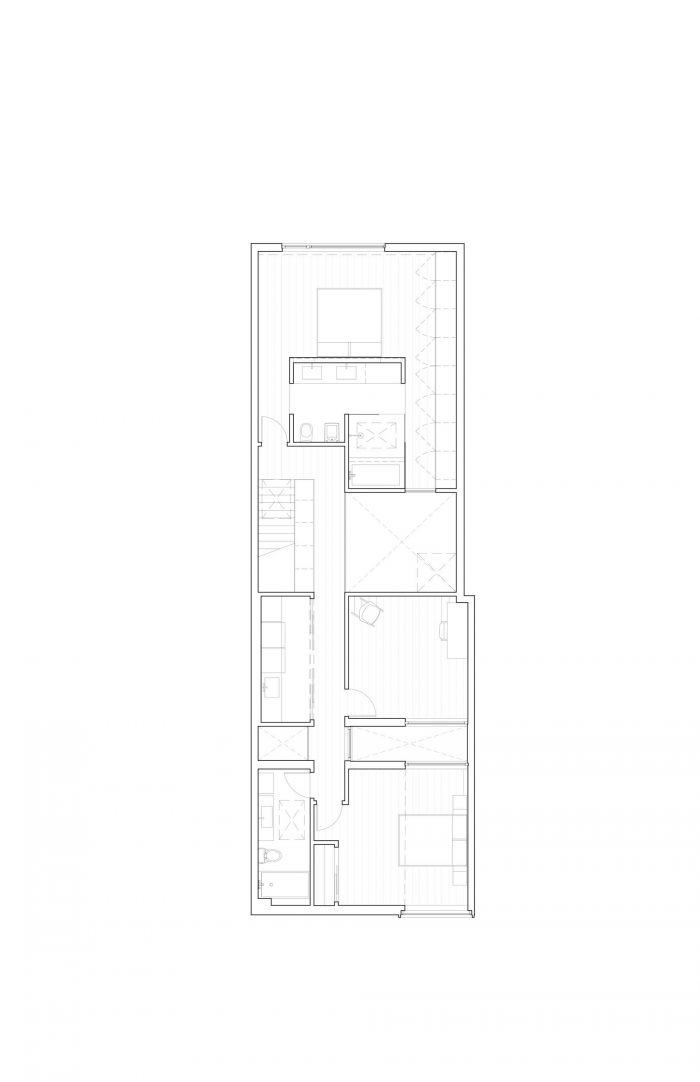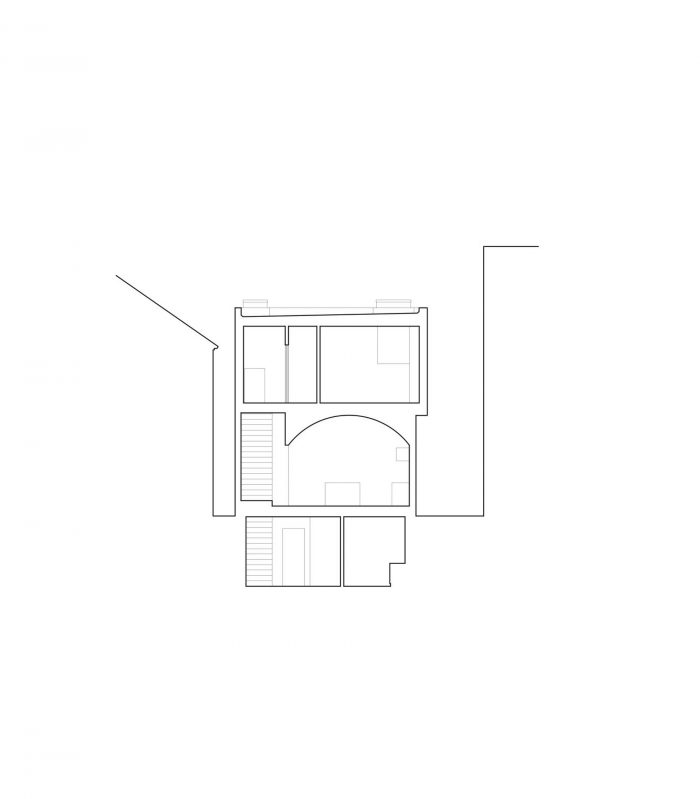在当今混乱的生活中,一个家需要成为一个避难所,一个让屋主隐居的地方。该项目是为一对意大利夫妇建造的,设计既向客户的意大利传统致敬,也向多伦多的住宅建筑结构致敬,同时确保了对健康、流动性和便利性的敏感度。
In the chaos of life today a home needs to be a place of refuge, a solitude for the homeowners to retreat to. Built for an Italian couple, the design pays homage both to the clients’ Italian heritage and that of the Toronto residential building fabric, while ensuring a sensitivity towards wellbeing, mobility, and convenience.
太平洋项目的设计源于业主的价值观和传统,在这里,他们过去的舒适感在现今的生活中得到了充分的体现。穹顶,在它的许多变化中,是古罗马建筑中最常见的原型之一,其特点是对光线的强大调制和它的轻盈感。
The design of the Pacific project is born from the homeowners’ values and traditions where the comforts of their past are now viscerally felt within their present-day lives. The vault, in its many permutations, is one of the most common archetypes of ancient Roman architecture, characterized by its powerful modulation of light and its sense of lightness.
在将这一原型采用到住宅空间中时,建筑师将穹顶从其主要形式中演化出来,将其穿刺、切割、剥离成新的几何图形,有助于将光线和空气分配到关键位置,响应程序组织,划定每个位置都有不同的氛围,并在整个房屋中创造出一种截面上的连续性。在将业主过去的神圣内容带入现在的过程中,他们被带入了另一个时间和地点,充满了故事、意义和记忆,成为他们的避难所。
In adopting this typology into a domestic space, the architects evolved the vault from its primary form, puncturing, cutting, and peeling it into new geometries that help to distribute light and air into key locations, respond to program organization, demarcating each with a different atmosphere, and create a sectional continuity throughout the house. In carrying sacred content from the homeowner’s past into the present they are transported into another time and place, full of stories, meaning, and memories that become their refuge.
拱顶的几何形状延伸了地块的长度,告知了立面和室内的关系。从外观上看,砖砌的拱顶是整体性砖砌正面的减法。这种整体性的立面是通过注重砖块的丰富材料性,以及与邻家房屋比例相映成趣的孤立穹顶来创造的。覆盖外立面的砖块和包裹车棚天花板和墙壁的砖块,发挥了多伦多砖石细节的历史。在多伦多的住宅结构中,砖的传统可以追溯到19世纪,当时多伦多的维多利亚式房屋存量建成。在这些房屋中,装饰性的细节呈现在位于孔洞上方、角落和檐角处的砖缝中的单个孤立时刻。
The vault geometry extends the length of the lot, informing a relationship between the façade and the interior. From the exterior, the brick vault is a subtraction from the otherwise monolithic brick frontage. This monolithic façade is created through a focus on the rich materiality of the brick coursing, and the isolated dormer which mirrors the proportions of the neighboring house. The brickwork that covers the façade and wraps the ceiling and walls of the carport plays into Toronto’s history of masonry detailing. The tradition of brick in Toronto’s residential fabric dates back to the 19th century when Toronto’s stock of Victorian houses was built. In these houses, ornamental detail presents itself in single isolated moments of brick coursing located above apertures, along with corners, and at cornices.
建筑师们把这种单一的装饰性时刻炸开了。住宅的正面被缩减为一个整体的立面–其中单一重复的材料装饰,是对佛兰芒债券的一种适应,变成了一个均匀但有质感的砖场,强调拱顶的轮廓。这个图案领域强调了光和影的游戏,并抓住了季节性的变化。在夏季,突起的纹理与鲜明的阴影的立面,而在冬季,纹理通过砖块转换,创造了雪落的架子。
The architects took this singular moment of ornamentation and blew it up. The front of the home is reduced to a monolithic façade – where single repetitive material ornamentation, an adaptation of the Flemish-bond, becomes an even but textured brickfield placing emphasis on the vaulted profile. This field of patterning emphasizes a play of light and shadow and picks up on seasonal changes. In the summer, the protrusions texture the façade with stark shadows, and in the winter the texture transforms through bricks creating shelves for the snow to fall on.
作为一对打算居家养老的退休夫妇,他们必须在现场有停车位。为了避免车库前的郊区街道的愚蠢,决定建造一个车棚,这决定了整个项目的形式组织。综合车棚刻画了正面的立面,创造了一个让人联想到门廊的行进式入口,这是罗马建筑中的一种建筑特征,通常以拱顶或柱廊的形式覆盖并延伸到入口处。
As a retired couple intending to age in place, it was essential that they had access to parking on site. Wanting to refrain from the suburban folly of a garage-fronted street, the decision to create a carport shaped the formal organization of the entire project. The integrated carport carves the front façade, creating a processional entryway reminiscent of the portico; an architectural feature found in roman architecture which covers and extends from the entrance often as a vault or colonnade.
拱顶门廊也是多伦多维多利亚时期房屋的一种普遍形式。多伦多的住宅区街道往往以前廊(而不是车库)作为点缀,以创造街道和住宅之间的过渡空间。在太平洋住宅的案例中,雕刻的车棚形成了一个倒置的门廊,在街道上创造了一个内敛的存在。一个贯穿建筑高度的采光井被安置在车棚的深处,用光线冲刷深邃的空间,将访客拉向入口。这个装甲空间向内,被认为是私人空间,创造了一个私密的入口队伍。
Vaulted porches are also a prevalent form in Toronto’s Victorian housing stock. Toronto’s residential streets are often punctuated by front porches (rather than garages) to create a transitional space between the street and the home. In the case of Pacific Residence, the carved carport creates an inverted porch, which creates an introverted presence on the street. A lightwell that cuts through the height of the building is placed at the depth of the carport, washing the deep space with light, pulling visitors towards the entry. This armored space is turned inward and perceived as private, creating an intimate entry procession.
为了强调项目的几何简约性,所有的流通、服务和入口条件都被塞进了与车棚相邻的直线条中。进入房屋后,参观者从一个压缩的服务 “吧台 “开始,然后进入底层广阔而通风的生活空间。在整个底层的长度中,桶形拱顶持久的几何形状将这些生活空间连接起来,突出了客户在食物准备、饮食和社交方面的连接性愿望。
To emphasize the project’s geometric simplicity, all circulation, services, and entry conditions are tucked into a linear bar that runs adjacent to the vault. Upon entering the house, visitors begin in a compressed service ‘bar’, which then opens into the ground floor’s expansive and airy living spaces. Throughout the length of the ground floor, the barrel vault’s persistent geometry connects these living spaces, accentuating the client’s desire for connectivity in food preparation, eating, and socializing.
虽然桶形拱顶将这些空间融合在一起,但通过拱顶上的切线剥离和切割,可以发现衔接和缓解的时刻。拱顶在餐厅中保持完整,在厨房的长度上被切开,在客厅中再次变得完整,然后展开并剥离到后院。这样在空间上划定了相连的空间,同时也让自然光涌入深邃狭窄的地段。坐落在长形平面图的中间,厨房敞开,从上方的天窗透出自然光。
While the barrel vault brings these spaces together, moments of articulation and relief are found through tangential peels and cuts in the vaulted ceiling. The vault remains intact in the dining room, is cut at the length of the kitchen, becomes intact again in the living room, and then unfolds and peels into the backyard. This spatially delineates connected spaces, while also providing natural light to flood into the deep and narrow lot. Situated in the middle of a long floorplan, the kitchen opens and is flooded with natural light from a skylight above.
虽然底层仍然是畅通无阻的连接,但二层却被切成了由桥梁连接的房间。这使得房间可以叠加在一个狭窄的地段,自然的日光可以到达每个房间和下面的底层。在这一层,洗衣房、卫生间、楼梯等服务设施也被塞进了 “吧台 “里,而卧室、书房、主卧则从房子的前面向后面叠加。卧室和书房之间的切面让两个房间都能分享从采光井和立面的天窗带来的自然日光。主人套房从房子的后立面和厨房上方的天窗都有照明。
While the ground floor remains unimpeded and connected, the second floor is sliced into rooms connected by bridges. This allows for rooms to be stacked in a narrow lot with natural daylight reaching each room and the ground floor below. On this floor, the services of the laundry room, bathroom, and stairs are also tucked into the ‘bar’, while the bedroom, study, and master suite are stacked from the front to the back of the house. The slice between the bedroom and study allows both rooms to share natural daylight brought in from the lightwell and the façade’s dormer window. The master suite is lit from both the house’s back façade and the skylight above the kitchen.
建筑师:Batay-Csorba Architects
面积:3500平方英尺
年份:2020年
摄影作品:Doublespace Photography
城市:多伦多
国家:加拿大
Architects: Batay-Csorba Architects
Area: 3500 ft²
Year: 2020
Photographs: Doublespace Photography
City:Toronto
Country:Canada

